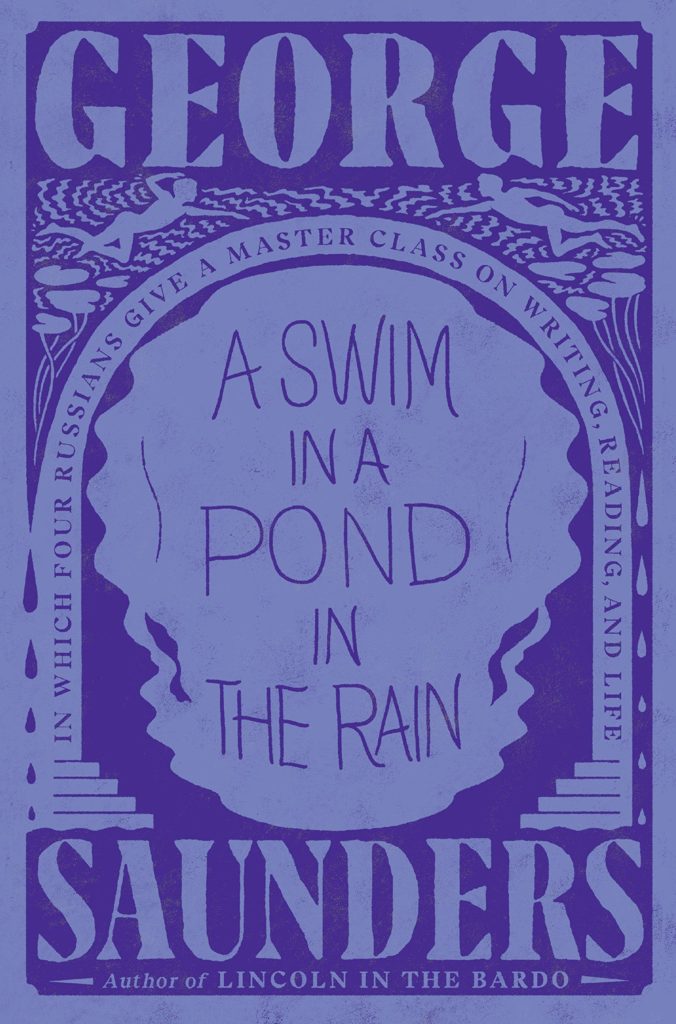Doubtless George Saunders’s A Swim in a Pond in the Rain: In Which Four Russians Give a Master Class on Writing, Reading, and Life has been reviewed to a frazzle by now, but I also believe many of Black Fox’s readers have not read this hugely informative book. It is worth reviewing for those readers because it is a window into the creative theories of one of our masters of the short story form, Saunders himself (considered by many the best short story writer in English today), and because the masterful Russian writers analyzed in this book, particularly Chekhov and Tolstoy, are such fertile ground for inspiration.
The four Russian short story writers whose work Saunders analyzes are Anton Chekhov, Nikolai Gogol, Leo Tolstoy, and Ivan Turgenev. Saunders’s method, except with the first story (which he presents piecemeal), is to offer the story for the aspiring writer to read entire, then to provide an interpretive analysis, and finally to finish with an “Afterthought,” in which further lessons are extrapolated. Saunders’s book is invaluable because, as one might expect of this writer, his postulates are utterly unique, are unlike advice you would get from any other fiction writer. The stories he visits are, in order, Chekhov’s “In the Cart,” Turgenev’s “The Singers,” Chekhov’s “The Darling,” Tolstoy’s “Master and Man,” Gogol’s “The Nose,” Chekhov’s “Gooseberries,” and Tolstoy’s “Alyosha the Pot.” (The last-named story is the only one I feel he could have left out: to my mind, this is one of Tolstoy’s worst short stories. Any of a dozen Tolstoy stories, I believe, would have made better reading and better material for analysis. For one thing, Tolstoy was a past master at describing action, and a story like “How Much Land Does a Man Need?” gives him ample latitude for displaying this formidable talent, as do several others of his stories.)
But A Swim in a Pond in the Rain is chock full of useful insights. One of the most useful for me comes when Saunders is analyzing the first page of “In the Cart.” He says that he does not much like the word “plot”: “let’s replace it with ‘meaningful action.’” He expands upon what he means by that; meaningful action is action that engages the mind and imagination of the reader and advances the narrative. Personally, I can live with that concept much easier than I have ever been able to do with that of plot, which has always seemed too artificial to me. And this is only one example of the way Saunders continually surprises us with an idiosyncratic slant on the craft of fiction writing.
He also surprises with his interpretations of the writers’ intentions with respect to technique. No better example of that is his analysis of the second story in the book, Turgenev’s “The Singers.” Saunders interprets all of Turgenev’s “digressions and static descriptions” as being done “on purpose.” They function, in the context of the singing contest, symbolically, he says, because the winner of the contest is not as technically proficient as the loser, but he is able to move his audience to tears. Turgenev is saying in effect, “No, I am not technically proficient, but I can move a reader profoundly, so I have in abundance the essential talent of a good storyteller” (I am compacting Saunders’s argument into a few words here and perhaps doing violence to it; he does not use my phrasing). I did not find Saunders altogether persuasive on “The Singers,” which is badly narrated; I do not believe clumsy storytelling can be made symbolic (although “The Singers” triumphs despite shortcomings). But Saunders’s handling of Turgenev is an example of his gift for surprising in every block of text in the book.
Some of the signature concepts in the book are Saunders’s definition of characterization as resulting from “increasing specification,” that is, adding greater specification of character as you go along; of every structural unit in a story, that it needs to (1) be entertaining in its own right and (2) advance the story in a non-trivial way; of a story as an organic whole (“and when we say a story is good, we’re saying that it responds alertly to itself,” he says); of a story as linear, proceeding line by line (admittedly not a unique concept); of the story form as being ruthlessly efficient (“let’s call it the Ruthless Efficiency Principle (REP)”); and of a story as being “not like real life; it’s like a table with just a few things on it.”
And these remarks are just from his analysis of the first story in the book. He goes on in this way, surprising us with novel concepts about storytelling, throughout a book of revelations about his view of the art of the short story. He informs us early on that we are not to take everything he says as gospel: if you do not find a suggestion useful, ignore it, he says—which is as it should be. A book on writing craft should not be autocratic. But even if you find little of his advice gratifying to your own muse, the book will still be well worth your time simply for the insight it gives into not only Saunders’s own practice, but into that of many of the young writers who have come through the MFA program at Syracuse University. A Swim in a Pond in the Rain represents a freehold estate in the contemporary Zeitgeist (and not only for its ideas about art, but for its remarks on life). It will be well worth any avid reader’s time and money. It is only one more in Saunders’s oeuvre of remarkable books.





great review!